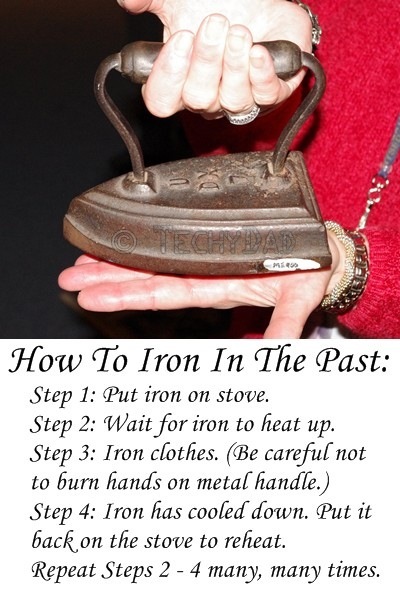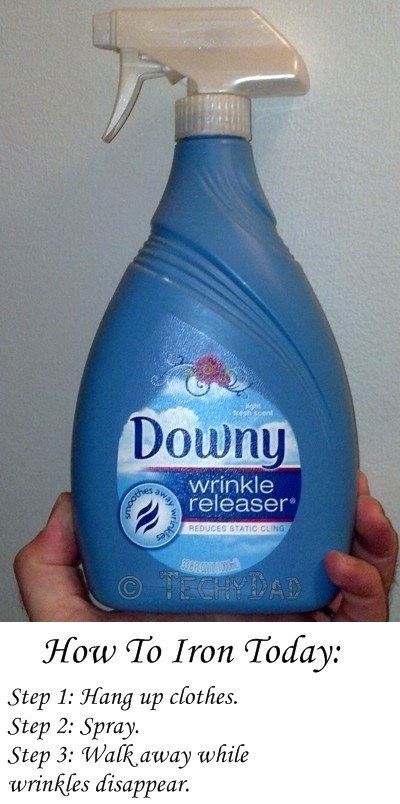Author: TechyDad
A Lesson In Tough Times
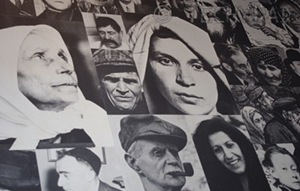 A few days ago, NHL lamented about how rough his life was because I was sending him to bed without him having dessert. (Dessert isn’t an "every night" proposition in our house, but the kids keep lobbying for it to be a required part of dinner.) This "hard knock life" moment was contrasted with a program we attended at the New York State Museum. During the various components of this program, NHL got to see just what immigrants (especially Jewish immigrants) who came to America in the early 1900’s had to deal with.
A few days ago, NHL lamented about how rough his life was because I was sending him to bed without him having dessert. (Dessert isn’t an "every night" proposition in our house, but the kids keep lobbying for it to be a required part of dinner.) This "hard knock life" moment was contrasted with a program we attended at the New York State Museum. During the various components of this program, NHL got to see just what immigrants (especially Jewish immigrants) who came to America in the early 1900’s had to deal with.
Driven Far From Home
We started out with viewing the opening scenes from American Tail. The Mousekewitz family is celebrating Chanukah when a gang of cats (belonging to the Cossacks) raids their village. Their home is burned to the ground, but luckily they survive. This was actually a pretty good portrayal of the real happenings in Russia at the time. Jewish villages would be raided and Jews would, at best, lose much of their meager belongings. At worst, they could lose their lives or the lives of their loved ones. The situation was horrible with no chance of improving, so they left everything they knew behind to head to America.
I spoke with NHL about this and asked him to imagine being in that situation. I told him to pretend that we were leaving and he could bring one item with him. Maybe a stuffed toy, maybe a book, but only one. He said that he didn’t know what he would choose, realizing what a horrible decision it would be for a child to have to make.
Sea Sick and Worse
After a long trek to a port, the fleeing refugees would be packed on a ship. And I do mean packed. The ship’s owner was earning profits based on how many people were stuffed onto a boat. The more on board, the more money he made. Whether these people had enough room to move around (they didn’t), had room enough to sleep (they didn’t), or had enough food (which they had to bring with them) didn’t matter. What mattered was putting a few more paying customers on the boat so that the boat’s owner would get more money.
The trip would take months. Kids, cooped up below decks on the ship, would go stir crazy. I’ve parented kids who went stir-crazy after a few too many days stuck indoors due to bad weather. That was tough. But in my case, my kids had adequate food, facilities, toys, etc. The kids-stuck-on-an-overcrowded-boat-for-months-with-nothing-to-do level of stir-crazy strikes any parent with sheer terror.
Speaking of adequate facilities: At one point, the presenter described the "facilities" on the boat. You would get a bucket which you did your business in. As she said this, I noticed two girls at the far end of our group. Their faces showed overwhelming disgust at the thought of this situation. Of course, once the presenter mentioned how you would then be responsible for dumping your "business" overboard and washing out the bucket for the next person, the girls looked like they would be sick right then and there.
Destination Reached… Or Was It?
 Once the weary travellers arrived in America, they would be processed at Ellis Island. Many would get through, but sometimes individuals would be identified as being ill. (After all, crowded boat + "no facilities" + no medical care + long trip equals illnesses running rampant.) If you were marked at sick, you would be put on a boat back home. It didn’t matter if your entire family had gone through already. Children would be sent home by themselves while their parents would be let through.
Once the weary travellers arrived in America, they would be processed at Ellis Island. Many would get through, but sometimes individuals would be identified as being ill. (After all, crowded boat + "no facilities" + no medical care + long trip equals illnesses running rampant.) If you were marked at sick, you would be put on a boat back home. It didn’t matter if your entire family had gone through already. Children would be sent home by themselves while their parents would be let through.
Tough Life In The New World
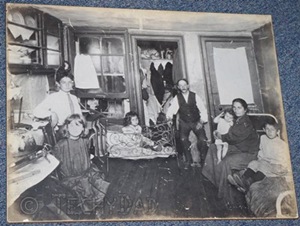 If the travellers were admitted into America, they didn’t face "streets paved with gold." Instead, they would get to share a tiny apartment with 6 other people. Four of those apartments would share a single bathroom. There would also be a language barrier (which one presenter simulated by speaking to us for over five minutes in fluent Hebrew while we looked puzzled).
If the travellers were admitted into America, they didn’t face "streets paved with gold." Instead, they would get to share a tiny apartment with 6 other people. Four of those apartments would share a single bathroom. There would also be a language barrier (which one presenter simulated by speaking to us for over five minutes in fluent Hebrew while we looked puzzled).
Perhaps the worst, though, was the presenter who described the working situation. Children as young as 9 would work long days – 6am to 10pm. They would earn five dollars a week, if they were lucky, but would also often have their pay docked for such things as renting the chair they sat in, paying for the thread they used in their job to sew garments, and taking too long going to the bathroom.
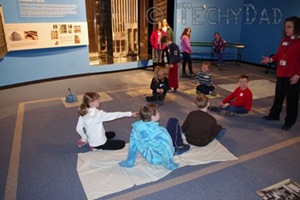 This presentation led to NHL and me talking about how he would feel about being forced to work like this. NHL is a big early bird, frequently waking up at 5:30am, but were we living in this time, he would need to wake up as much as an hour earlier. In addition, while he goes to sleep at 8pm now, were he working like the immigrants did, he wouldn’t get to sleep until after 11pm.
This presentation led to NHL and me talking about how he would feel about being forced to work like this. NHL is a big early bird, frequently waking up at 5:30am, but were we living in this time, he would need to wake up as much as an hour earlier. In addition, while he goes to sleep at 8pm now, were he working like the immigrants did, he wouldn’t get to sleep until after 11pm.
Reevaluating The Hard Life
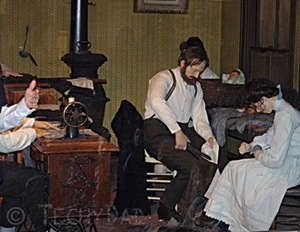 After this presentation, NHL not only came away having learned about a big part of our history. Perhaps even better, he left with a renewed appreciation for his own life. He gets to sleep in a comfortable bed, the extent of his "work" is homework for school, has toys to play with, and has plenty of room to move around and play. His life is infinitely better than that of our immigrant ancestors. Of course, were it not for them leaving everything they’ve ever known behind and braving unimaginable hurdles, our lives would not be as good as they are.
After this presentation, NHL not only came away having learned about a big part of our history. Perhaps even better, he left with a renewed appreciation for his own life. He gets to sleep in a comfortable bed, the extent of his "work" is homework for school, has toys to play with, and has plenty of room to move around and play. His life is infinitely better than that of our immigrant ancestors. Of course, were it not for them leaving everything they’ve ever known behind and braving unimaginable hurdles, our lives would not be as good as they are.
My Son, The Artist
Both of my boys love art projects, as the mounds of paper that we’ve collected over the years attest to. Recently, however, NHL got to be a part of something bigger. His school, and many more, had students reinterpret some pieces of art found in the New York State Museum. The artwork was put on display in the Empire State Plaza’s concourse near the New York State Museum.

Over the weekend, we stopped by the exhibit to have a look. After some searching, we quickly found NHL’s art.
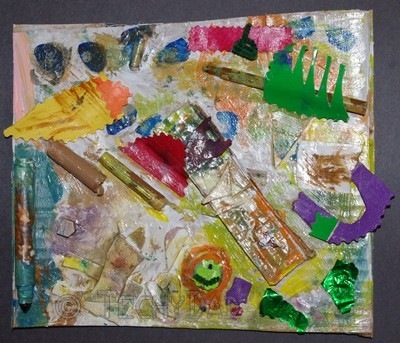
We were so proud of NHL. He did a fantastic job. We even got our artist to pose for a photo with his artwork. (Begrudgingly, he doesn’t seem to like having his picture taken.)

Of course, JSL felt left out so he posed with the artwork as well.

We also looked at all of the other art pieces on display. NHL loved pointing out his classmates’ art that was hanging up. Meanwhile, all of us enjoyed seeing the various pieces.


It is clear that there are some very talented artists in our schools. Here is hoping that we get to see some more amazing pieces from them in the years to come.
TV Rewind Addiction
 One of the fun parts about being a parent is introducing your kids to shows that you grew up with. I’ve shown my boys Spiderman and his Amazing Friends, Rugrats, , Animaniacs, and even Teenage Mutant Ninja Turtles (via the new series since the 80’s series isn’t available to stream).
One of the fun parts about being a parent is introducing your kids to shows that you grew up with. I’ve shown my boys Spiderman and his Amazing Friends, Rugrats, , Animaniacs, and even Teenage Mutant Ninja Turtles (via the new series since the 80’s series isn’t available to stream).
Their latest retro streaming obsession, however, is Rocky and Bullwinkle. I t began with me playing a few Fractured Fairy Tales for NHL. He wasn’t enthusiastic about seeing it, at first. I guess he assumed that "show dad used to watch when he was a kid" would equal "boring." (No matter how many shows they come to like that I introduce them to, they always seem to assume this.) After seeing the first one, however, NHL begged to see another and another. Soon, he was showing them to his brother and they were laughing at the fairy tales gone wrong.
Then, they discovered Moose and Squirrel. NHL is now obsessive about seeing every episode. He got really upset when, after returning from a quick supermarket run with me, he saw JSL watching an episode he hadn’t seen. It looks like another win for Shows Dad Loved Watching.
Note: The moose image above is by Seeman and the squirrel is by helicopterjeff. Both images are available via MorgueFile.com.
FollowerHQ Launch and Mobile App
![]() Back in November of 2011, after many months of development, I launched FollowerHQ. This was my first major Twitter application. For those who haven’t used FollowerHQ, it’s goal is to help you manage your Twitter followers. Other tools will let you automatically follow everyone who follows you, but I didn’t want to do that. If I did, companies that I’m not interested in might follow me only for the automatic follow back. They could then pollute my Twitter stream with tweets that I don’t care about.
Back in November of 2011, after many months of development, I launched FollowerHQ. This was my first major Twitter application. For those who haven’t used FollowerHQ, it’s goal is to help you manage your Twitter followers. Other tools will let you automatically follow everyone who follows you, but I didn’t want to do that. If I did, companies that I’m not interested in might follow me only for the automatic follow back. They could then pollute my Twitter stream with tweets that I don’t care about.
FollowerHQ shows you who is following you that you aren’t following back. It lists detailed information such as how many followers they have and when their last tweet was. You can use this information to determine whether or not you want to follow them back. Perhaps you might ignore some followers because they haven’t tweeted in a long time. Maybe you might pass over some others because they don’t have any followers or seem like spammers. Or, perhaps, you will choose to follow some users who tweet about subjects that you find intriguing.
In addition, FollowerHQ will show you who isn’t following you back. As with people you aren’t following back, you can decide to ignore this situation, or you can decide to unfollow the accounts. Finally, FollowerHQ will track your followers and will show you who you have unfollowed. This is useful for the seemingly all-too-frequent times when Twitter decides to automatically make you unfollow someone when you didn’t want to.
Major Upgrade
The previous version of FollowerHQ was good, but it had one major flaw. It needed to work while the user was waiting. The user would open the page and FollowerHQ would start pulling information from Twitter’s API. Since Twitter limits how much data you can pull at once, this meant that the application could be slow at times. If the person running FollowerHQ only had a thousand followers, it might not be too bad. If they had a hundred thousand, however, it was unusable. Even worse, if the browser crashed, you would lose all of your progress and would need to start from scratch. Needless to say, this limited FollowerHQ’s usefulness.
For the new version of FollowerHQ, I ditched the "real time load" and went with a report request. Once you request a FollowerHQ report, it will queue up in the system. FollowerHQ will then process these report requests behind the scenes, completely separate from the users’ browsers. You can close your browser and even shut down your computer because FollowerHQ is running on my server.
When FollowerHQ is done, it will e-mail the user to notify them. They can then log in to view the report. Since the report information is pulled from my database and not from Twitter, the report comes up nearly instantly. (I also used Google’s PageSpeed analysis to speed up the site.)
Now Available as an Android App
I’m also testing out ways of packaging FollowerHQ as a mobile application. The first of these attempts utilized AppsGeyser. I’m very happy with this approach so far. AppsGeyser: 1) packages a special web browser that has no controls of its own and points to my site by default, 2) bundles said browser into an Android app, and 3) gives it all of the usual app characteristics such as being able to put an icon on the device’s home screen. As a bonus, there are no ads (unless I want to include some which would give me some revenue) and I can submit my app to the Google Play store.
I’ve wanted to get into app development for awhile so this is highly intriguing. I might make a "mobile.FollowerHQ.com" version of my Twitter application for the app to launch, however. I also want to find similar tools to utilize to create an iOS app.
With all of the changes I’ve made to FollowerHQ, I’ve love to hear what you think. Head on over to http://www.FollowerHQ.com/ and give it a try. Post what you think about it here.

